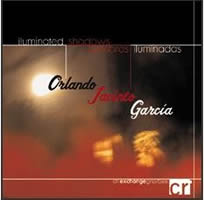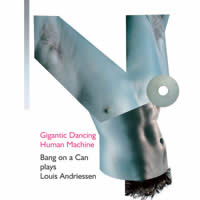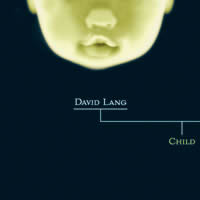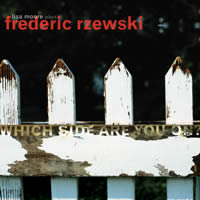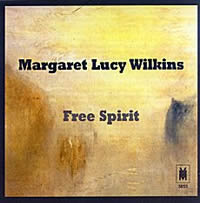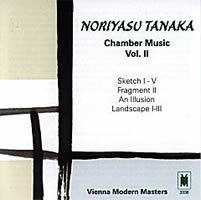A Dernier CRI, Slices of Cantaloupe, and Schlag from Vienna Modern Masters
|
Grant Chu Covell [October 2003.]
“Illuminated Shadows / Sombras Iluminados.” Orlando Jacinto GARCÍA: Paisaje del sonido II (Soundscapes II) (2000); Entre el anochecer y la oscuridad (Between Nightfall and Darkness) (1992); Imagenes (sonidos) sonoros congelados (Suspended Sonic Images) (1999); Sombras iluminados (Illuminated Shadows) (1997). Luis Gomez Imbert (bass), The Miami String Quartet; Angel Lemus (viola), Orquesta Sinfonica de Valencia, Ernest Martinez Izquierdo (cond.); Robert Davidovici (violin); Orquesta Ciudad de Malaga, Odon Alonso (cond.). CRI 900. This is one of CRI’s most persuasive releases and also one of its last. The listener will seize on García’s heritage — he’s a Cuban émigré — and look for Latin effects. But García’s music rises above ethnic mannerisms by way of a unique vocabulary and a wide base of influence. García studied with Feldman. It’s very obvious. Entre el anochecer y la oscuridad (Between Nightfall and Darkness) for viola and orchestra, whose very instrumentation parallels Feldman’s The Viola in My Life, opens with a dense chord right out of For Samuel Beckett. We hear delicate passages built from innocent repetitions much like Rothko Chapel. But while Feldman is cool and stoic (those Buffalo winters?), García deals out a wider range of emotions centering on loneliness and desperation. Perhaps it’s the inherent nature of slow solo viola lines or that García artfully lessens the pulse by reducing the strength of the accompanying orchestra and using percussion to create soft blankets of noise. Violist Angel Lemus mounts a valiant effort, marred only by live audience noise. Following chronologically, Sombras iluminados (Illuminated Shadows) for orchestra clocks in at less than 20 minutes. Imagine klangfarbenmelodie slowed to a crawl. García appropriates small gestures, perhaps fit for Boulez, slathers them with Brucknerian opulence, and then magnifies and repeats them. Towards the end there are delicate repetitions à la Feldman over chords harkening back to Schoenberg’s Farben, Op. 16 No. 3. It’s interesting and well-performed by the Orquesta Ciudad de Malaga under Odon Alonso, but lacks that special spark found in the other three works. The remaining two pieces are vehicles for solo strings. Imagenes (sonidos) sonoros congelados (Suspended Sonic Images) pits a solo violin against a tape of collaged violins. Resemblance to Nono’s La lontananza nostalgica utopica futura may be intentional in both instrumentation and theatricality. As the piece progresses, the violinist moves to music stands at the back of the stage. But the musical material is less coarse and without violent contrasts, like Paganini heard through a kaleidoscope. It’s hard to tell just what violinist Robert Davidovici is up to. The most recent piece is the first on the disc, Paisaje del sonido II (Soundscapes II), for solo contrabass, string quartet, and three percussionists playing wind chimes and glasses. It’s a captivating work whose bewildering intensity and variety are generated by a mere eight players. We’re back in Feldman’s shadow — maybe in Gloria Coates’ backyard — but García creates something elemental and primordial. The bass and quartet glide and quiver throughout; pitch material is secondary to texture and color. The solo part is difficult, demanding complete control over the instrument. This is something Scodanibbio should perform, but Luis Gomez Imbert does an amazing job and leaves nothing wanting. To repeat, this kicking disc is one of CRI’s last, and you should seek it out. Happily, ArkivMusic (http://www.arkivmusic.com/) carries it at a remainder price. The shuttering of CRI marks the end of one of America’s most curious independents. Launched in 1954 and predominantly populated with freshly minted contemporary music, CRI’s vast catalog has something for everybody. It’s been said that CRI was basically a vanity label for aloof academics. With clunky graphics and rub-off lettering, some LPs probably did leave the impression that the music’s public consists of the composers’ immediate families. But as CDs displaced LPs, CRI attempted to cast off its ivory-tower reputation with several sub-series: Gay American Composers and the curiously named Emergency Music. The American Masters CD reissues of back-catalog LPs were especially welcome. Fortunately New World Records (http://www.newworldrecords.org/) is absorbing the entire catalog, so all is not lost. In the midst of this transition, CRI product can be had very cheaply, if you can find it. Qualiton (http://www.qualiton.com/) is running a closeout sale, and Verge Music (http://www.vergemusic.com/) is working through their inventory. The granddaddy of cutout land, Berkshire Record Outlet (http://www.berkshirerecordoutlet.com/), is also a good place to check. A vulture-collector, I ordered a few from Verge. I got CRI 768 with George Rochberg’s Symphony No. 2 (1955-56), an underappreciated blend of serialism and Varèse, Ruth Crawford’s chamber music (CRI 658), and Roger Sessions’ first three symphonies (CRI 573). Other bargains: Ives playing Ives (CRI 810), Maro Ajemian performing Cage’s Sonatas and Interludes (CRI 700), and for fun, David Del Tredici’s Alice Symphony. Elsewhere in these pages I’ve plugged CRI 620 with music of Feldman, and a favorite LP, Charles Amirkhanian’s Mental Radio (CRI SD 523). There are plenty of other good labels out there. Bridge Records (http://www.bridgerecords.com/), mode (http://www.mode.com/), and Lovely Music (http://www.lovely.com/) are among those that will survive because they’re more consistent in focusing on specific composers or genres. Cantaloupe Music (http://www.cantaloupemusic.com/) is the CD arm of the Bang on a Can troupe. They’ve released discs of exceptional quality: refreshing, arresting, and most importantly, entertaining. The label focuses on music written and performed by their members and friends. Here’s a selection of recent releases (Michael Gordon’s Decasia was taken up here).
“Gigantic Dancing Human Machine.” Louis ANDRIESSEN: Workers Union (1975); Hoketus (1976); Hout (1991). Bang on a Can All-Stars, et al. Cantaloupe CA21012 (http://www.cantaloupemusic.com/). Distributed in the US by Harmonia Mundi (http://www.harmoniamundi.com/). Workers Union and Hoketus announced Andriessen’s radical style of the 1970s, a collaborative minimalism meant to fly in the face of musical and social conventions. The music remains vital today. There are no notes in Workers Union. Andriessen specifies rhythm, dynamics and contours, leaving the choice of instruments and pitches up to the performers (“for any loud-sounding group of instruments,” the score says). The Bang on a Can All-Stars (Robert Black, bass; David Cossin, vibraphone; Lisa Moore, piano; Mark Stewart, electric guitar; Wendy Sutter, cello; Evan Ziporyn, bass clarinet) offer a punchy and raucous reading. Applause at the end of Workers Union leads abruptly to Hoketus, the hottest work here. I once saw a copy of the score. Its small and odd-sized format suggests an eccentric chapbook, perhaps something simple that children could play. The reality is otherwise. Two matched groups (one each of panpipes, alto saxophones, congas, pianos, electric pianos and electric guitars) are on alternate sides of the performance space (on recordings they’re generally at left and right). As the title suggests (hoketus = hocketing), the groups never play together, but alternate, quickly tossing chords back and forth. It’s like sitting on the net line at a ping-pong tournament and following the ball’s motion with your head. Hoketus is of variable duration, and at 23:53 it seems short. Some of the Bang on a Can team is joined by extra players, including the amazing duo piano team of Cees van Zeeland and Gerard Bouwhuis. Zeeland and Bouwhuis recorded a phenomenal duo piano version of De Staat (Attacca 8949), Andriessen’s killer setting of Plato for four sopranos and four oboes doubling English horns. Hout, for tenor saxophone, marimba, piano and electric guitar (Ziporyn, Stewart and Moore are joined by percussionist Steven Schick), completes the disc. Reminiscent of modes and melodies from Andriessen’s De Stijl, the work is a fast-moving canon at the unison sounding like a melody just slightly out of phase. The different timbres plus precise playing make a rock-solid performance.
David LANG: Child (1999): My Very Empty Mouth, Sweet Air, Short Fall, Stick Figure, Little Eye. Sentieri Selvaggi, Carlo Boccadoro (cond.). Cantaloupe CA21013 (http://www.cantaloupemusic.com/). Distributed in the US by Harmonia Mundi (http://www.harmoniamundi.com/). This is a memorable disc of bittersweet chamber works tempered by minimalism. While the early works of Glass, Riley and Reich dwelled mercilessly upon simple materials, Lang is expansive, crafting intriguing melodies and writing cleverly for small ensembles. His pacing and architectural sense are astonishing, and he wraps up quickly. Common to the five compositions that constitute Child is the exploration of childhood experiences. In his notes, Lang downplays the nostalgic aspect, but it’s there, nurtured and brought to the surface by the top-notch Italian ensemble Sentieri Selvaggi that commissioned two of the pieces and here plays all of them. The disc’s graphics are a tad sinister. The lower half of an alabaster-colored baby’s face hovers expressionlessly over a black background. Set in motion by a solo violin, My Very Empty Mouth, for flute, bass clarinet, piano, violin, viola, and cello, is a forlorn moto perpetuo. Against an even pulse, extra beats enter and depart. The melody oscillates between two pitches wherein Sentieri Selvaggi demonstrates its excellent unison playing with just the right amount of key noise from the winds. I’m very fond of the second piece, Sweet Air, for flute, clarinet, piano, violin and cello. Winds double piano over light pizzicato creating a delightful blurry and mysterious trifle. The rhythms and melodic bits suggest salsa or something Cuban. Curiously, this one’s dedicated to Andriessen. At 4:05, Short Fall (for piccolo, piano, violin and cello) is a hasty barrage of forcefully played notes in a gradually descending narrow pitch range. It’s like watching sand fall through an egg timer. The longer Stick Figure frames a somber cello line with widely spaced decisive blasts from percussion and piano, the latter also contributing a slow-moving, wistful theme. Another favorite is the last piece, Little Eye, where a cello keeps busy over the accompaniment of four non-percussionists, at least one of whom plays the piano. A mesmerizing metallic sound, possibly metal bowls or sticks rubbing brake drum rims, adds to the flavor.
Frederic RZEWSKI: De Profundis (1992); North American Ballads: Dreadful Memories, Which side are you on?, Down by the Riverside, Winnsboro Cotton Mill Blues (1978-79). Lisa Moore (piano). Cantaloupe CA21014 (http://www.cantaloupemusic.com/). Distributed in the US by Harmonia Mundi (http://www.harmoniamundi.com/). Maybe it’s because I’m easily impressed by the music’s theatricality and handling of its political theme that I judge Rzewski’s De Profundis a very good piece indeed. The sticker on the jewel box — “Oscar Wilde in prison!” — has got to be one of the oddest come-ons ever. It would not work for the Quartet for the End or Schulhoff, nor does it work here. Rzewski combines piano music with texts Wilde wrote about his incarceration. The pianist talks, sings, hums, whistles and, perhaps most disconcertingly, moans and sighs suggestively. Essentially the pianist becomes Wilde, sharing and commenting upon his jail time. Moore, Bang on a Can’s founding pianist, rises to the challenge. A mild Australian accent is appropriate for Wilde’s clever, poetic words. She’s in complete control, her performance more solid than Rzewski’s own, though Rzewski’s quavering American tenor adds quite a bit on the seventh disc in the “Rzewski Plays Rzewski” brick (Nonesuch 79623). The four North American Ballads can be taken together or separately, much like Chopin’s set of four. Rzewski’s Ballads are rhapsodic meanderings on popular and political tunes, like Ives but with the message cranked up. Moore plays them with an easy grace and casualness. I especially like how she makes the walking bass in Down by the Riverside suggest a band of musicians fading into the distance.
Evan ZIPORYN: Shadow Bang. I Wayan Wija (voice), Bang on a Can All-Stars. Cantaloupe CA21015 (http://www.cantaloupemusic.com/). Distributed in the US by Harmonia Mundi (http://www.harmoniamundi.com/). Shadow Bang is a frisky, hallucinogenic hybrid of garage-band minimalism and Balinese shadow puppetry. Electric guitar and drums underpin the storyteller I Wayan Wija’s colorful tale, a spirited detour from the Hindu epic, the Ramayana. Core members of the Bang on a Can All-Stars (Black, Moore, Stewart, Sutter, Ziporyn) join with percussionist Eduardo Leandro. I Wayan Wija’s entrance consists of unhinged laughter. He assumes roles in brisk succession, creating realistic personalities and dialog. The music and story fit together completely and entertain even without the shadow puppets. The whole production has the casualness of a jazz combo playing a favorite standard, as if Bang on a Can and I Wayan Wija have done this many times and know how to spice up each performance. Vienna Modern Masters (http://www.xs4all.nl/~gdv/vmm/) has been in existence since 1990. Their roster is diverse, with less familiar names alongside 20th-century icons. The “Vienna” in the label name is misleading as VMM is a nonprofit American company and has released much non-Austrian music. Their ongoing “Music from Six Continents” series is well known, challenging most listeners to name six continents. There must be at least one underexposed composer willing to relocate to Antarctica.
“Free Spirit.” Margaret Lucy WILKINS: Musica Angelorum (1991); Struwwelpeter (1973); Burnt Sienna: Etude for String Trio (1974); 366″ for solo trombone (1986); Symphony (1989). Sofia Soloists Chamber Ensemble, Plamen Djuroc (cond.); Alison Wells (sop.), Firebird Ensemble, Barrie Webb (cond.); Timisoara Symphony Orchestra, Barrie Webb (cond.). VMM 3055 (http://www.xs4all.nl/~gdv/vmm/). Distributed in the US by CDeMUSIC (http://www.cdemusic.org/). One of VMM’s best new releases is devoted to Margaret Lucy Wilkins. Again we meet the Firebird Ensemble previously praised in a column focusing on Italian releases. Members of Firebird combine with mezzo soprano Alison Wells in Struwwelpeter, a set of six children’s rhymes set for soprano, three clarinets who double sax and bass clarinet, piano and percussion. Wilkins skillfully folds in allusions (Nono’s Il Canto Sospeso is probably the most obscure) to emphasize the text’s darker side. Three strings from Firebird give Burnt Sienna: Etude for String Trio, which satisfactorily explores a catalog of stringed-instrument effects. Firebird conductor and trombonist Barrie Webb takes on 366″ for solo trombone. As in the string trio, in 366″ we experience a wide gamut of effects and expression, from bombast to introspection. The recording effectively captures Webb’s spatial movement and footsteps. Musica Angelorum is a modest piece for 12 strings meant to bring life to the medieval pictures of angels playing music. Atmospheric effects such as glissandos and sul ponticello alternate with more customary massed string textures suggesting Strauss. Webb conducts the Timisoara Symphony Orchestra in Wilkins’ Symphony. Its three movements are played without pause, creating a whole perhaps modeled on Sibelius’ Seventh.
Other recent releases include “A Distant Land Unfurled,” presenting orchestral music by David Loeb (VMM 3054). A handful of orchestral works are lusciously played, among them a cantata for oboe and strings and delicate concert pieces for violin and orchestra. Loeb’s music proficiently blends European Romanticism with non-European modes and colors. VMM 2036 is a second volume of Noriyasu Tanaka’s intimate chamber music. Takemitsu may be a reference point, but there’s more of a European influence in these curiously delicate works that blend the brittleness of early Webern with the sounds of Debussy. Especially wonderful is the way flute and cello match and glide together as one in the four Sketches for flute, cello and piano.
Toshiyuki Shimada leads the Moravian Philharmonic in four varied works on VMM 3052. A succinct Lament for Kosovo: Adagio for Strings by Betty Beath breaks out of the Barber mold by matching expressive tonality with a gentler, less impassioned shape. David Fetherolf’s El Dia de los Muertos for choir and orchestra is a bleak foray through Revueltas territory with a generous helping of European pathos. David Patterson’s Cheap Trills pays homage to Victor Borge with solid doses of cartoon humor. Patterson’s skill at collage is one step above P.D.Q. Bach by dint of clever passages, e.g., a layering of Rachmaninoff atop Beethoven. I’ve come back to Aaron Rabushka’s Trombone Concerto, with trombonist Jiri Vydra. It’s appealing, catchy and amiably tuneful, especially in the last movement. Transitions in the first movement following the opening cadenza suggest Rabushka’s fondness for Nielsen. The orchestra’s commentary keeps the trombone from gravitating towards bravado and mindless marches. VMM releases are distributed in the US by CDeMUSIC (http://www.cdemusic.org/). [More Grant Chu Covell]
[Previous Article:
Florence Foster Jenkins & Friends on Naxos]
[Next Article:
Random Noise 1: Anouar Brahem on ECM]
|
